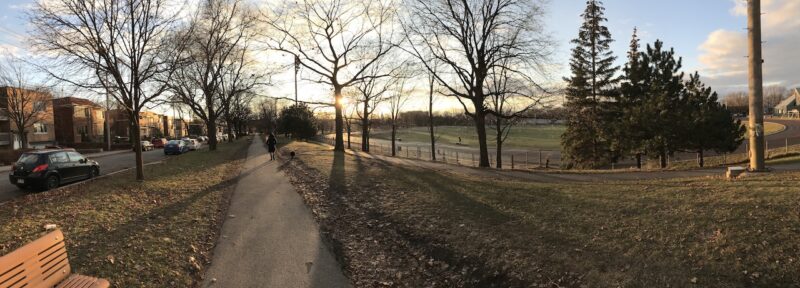The panoramic image is the photographic record of a visual experience, rich in terms of objective scope and subjective meaning, and obtained through the sweeping photography of a particular situation.
The making of it involves sensing the objective scope and subjective meaning of the situation and, commingly, seeing it as an image in our mind’s eye.
That commingling involves the intuitive framing and recording of the visual elements in the real situation that will eventually structure the panoramic image, helping it to recreate the on-site experience for the viewer of the image.
The feature image reprised below can begin to give us keys to such process:

Foremost is the slight depression of the field ahead of us which provides a sense of spatial unity.
Follow the straight line going between the top of the head near us and the tree across the depression from it and see how it engages our sense of “being there”.
Look at the children play area equipment, and how, as background, it seems to dialogue visually with the tree clumps left and right which, linked by the dark shadow line defining a foreground … et voilà !
The feature image therefore not only possesses the visual elements of a spatial structure but gives us also a meaningful sense of being there.
The following two groups of images illustrate the panoramic image spatial and temporal meaningful dimensions, the first going from the geographical to the local and the second going from the seasonal to the historical.
From the geographical to the local.
- The case of the river front linear park

A picnic table keeps company with the river side and its horizon while a bike trail is appropriated by early spring promeneurs. While the landscape elements structure the image, people and buildings seem to establish a scale of distances for the viewer.
A finer analysis would place, in complementary perceptual relations, the natural and the cultural elements of the image.
- The case of the urban park thematic areas

In this version of the feature image we have focused on the spatial distribution of occupants in order to structure the sense of depth of the image: from picnickers in the fore and middle grounds, to the children play area at middle to back grounds with the big-muscle playing field next to the park farthest edge lined with buildings.
That thematic structuring of the park is supported by its topography as the family picnic and children play areas are distributed in an undulating area which creates a variety of choices for activity location, while the big-muscle playing fields, flat by necessity to accommodate small to large team games, commingle perceptually with the edge of the park.
From the seasonal to the historical
- The case of the first snowfall

As sky and ground seem to reflect each other’s “greyness” the landscape elements, natural and man-made, seem, in dark attire, to mourn the passing of fall colors.
That greyness refers of course to the arrival of winter.
What used to be a pond now looks like it could invite skaters. What used to be comfortable seating under tree canopies are now abandonned by the passers-by who would rather stand by the pond and contemplate the first timid snow cover.
The late afternoon low light level seems to add to the mournful overtones as the heavily landscaped horizon, and the presence of the church and the utility structure, both welcoming shelters, add expressive elements of wintering to this panoramic image.
- The case of the death of a neighborhood shopping center.

It is a particularly moving moment in the history of the neighborhood that caused me to document these steel skeletons filled with memories of ‘coffee-klatching’ patients of the nearby re-adaptation center keeping company with the elders of the varied ethnic groups living in the neighborhood.
The store tenants who had become friendly figures, were of course the stalwarts of this part of neighborhood history, which corresponded to the waves of pre and post WW2 immigrations, and whose memory will now be lost among the piles of rubbles.
As end words …
… I offer this panoramic view of a lovely Montreal autumn soltice sunset, and its long shadows which remind me of the extended arms of the ancient Egyptian representation of their sungod.
Enjoy.

Credit all images to Maurice Amiel
